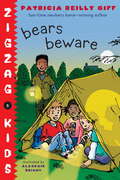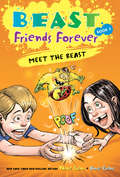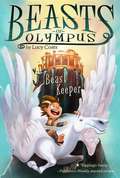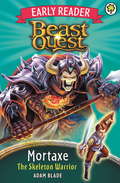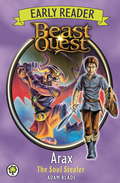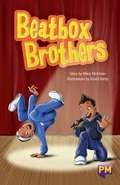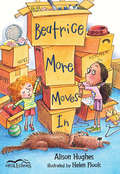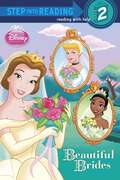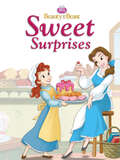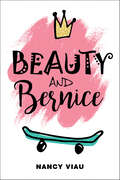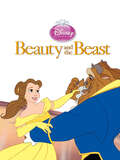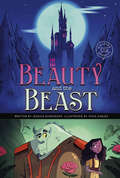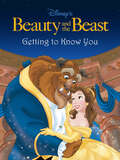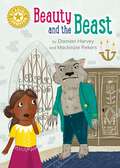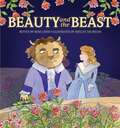- Table View
- List View
Bear's Sore Throat (Fountas & Pinnell Classroom, Guided Reading)
by Jennifer Morris Jacqueline AdamsNIMAC-sourced textbook. Bear's Helpers. Bear is very sick. Rabbit and the little snakes want to help him, but they're making things worse!
Bear's Tools (Fountas & Pinnell Classroom, Guided Reading Grade 1)
by Jennifer Morris Jacqueline AdamsNIMAC-sourced textbook
Bears Beware
by Patricia Reilly GiffMitchell really doesn't want to go camping with the other kids at the Zigzag Afternoon Center. Sleeping in the woods with creepy crawly things, coyotes, and bears? Yikes! But his best friend Habib is going, and it's Mitchell's birthday that weekend. He's just got to find a way to be brave, and scare the bears away!As the fifth book in the Zigzag Kids series--which also includes Number One Kid, Big Whopper, Flying Feet, and Star Time--Bears Beware continues to delight readers with award-winning author Patricia Reilly Giff's quirky, lovable group of kids, capturing all the excitement and surprises of new friends and after-school fun.From the Hardcover edition.
Beast Friends Forever
by Nate Evans Vince EvansMeet Otto! Zeke and Hannah's new best friend--even if he is a beast. It's up to Zeke and his sister to keep this mini-monster out of their candy, out of their school... and out of trouble! Will they be able to keep him a secret? Will the school bully discover why he's swinging upside down from the basketball hoop in his underpants? More importantly, what does Otto want with Hannah's dolls?
Beast Friends Forever: The Super Swap-O Surprise!
by Nate Evans Vince EvansNine-year-old Zeke and his seven-year-old sister Hannah have a furry, two-foot-tall beast named Otto living under Zeke's bed. In the second installment of this wacky series, the siblings experiment with Otto's magical "Swap-O" ability to exchange everyday item for interesting objects. Like a music box for a golden egg; a small robot for a tiny green man; and a tree for a. . . huge dinosaur! How will Hannah and Zeke get out of this scrape? Nate and Vince couple the laugh-out-loud story with equally zany illustrations and comic book sequences-perfect for the target audience.
Beast Keeper #1
by Lucy Coats Brett BeanBeasts of Olympus is a series of 144-page illustrated chapter books set in a magical Ancient Greece where strange things still walk the Earth. Beast Keeper tells the story of Pandemonius (a.k.a. "Demon," the half-god son of Pan) who, on his tenth birthday, is called upon to look after all the mythical creatures that belong to the stables of Olympus.
Beast Quest Early Reader: Mortaxe the Skeleton Warrior
by Adam BladeMortaxe the Skeleton Warrior has risen from the grave! He controls Avantia's six Good Beasts with dark magic, forcing them to fight Tom in a gladiatorial battle. Tom and his companions are about to face the most terrifying Quest of their lives...Beast Quest Early Readers, adapted from the original bestselling Beast Quest Specials, are perfect for children learning to read and for families to enjoy reading together. The text is vetted by a literacy expert and there are bright new full-colour illustrations throughout.Look out for Beast Quest Early Reader 6: Ravira, Ruler of the Underworld in September!
Beast Quest: Early Reader Arax the Soul Stealer
by Adam BladeArax the Soul Stealer has snatched away good Wizard Aduro's spirit, leaving the kingdom exposed to the evil of Wizard Malvel. To save Aduro, Tom tracks Arax to his cave - but the terrible Beast wants Tom's soul, too... Beast Quest Early Readers are perfect for children learning to read and for families to enjoy together, with text vetted by a literacy expert and bright new colour illustrations. Look out for Beast Quest Early Reader 4: Creta the Winged Terror in November!
Beast Quest: Early Reader Creta the Winged Terror
by Adam BladeEvil Wizard Malvel has conjured up Creta, a terrifying monster that can unleash thousands of vicious insects from its body! Can Tom defeat Creta before the Beast destroys the whole kingdom?Beast Quest Early Readers are perfect for children learning to read and for families to enjoy together, with text vetted by a literacy expert and bright new colour illustrations.Also available: Beast Quest Early Reader 3: Arax the Soul Stealer!
Beatbox Brothers (Into Reading, Level T #46)
by Marg McAlister David HardyNIMAC-sourced textbook <p><p> Jack's brother, Logan, is good at everything! He can breakdance, sing, and play the guitar. When Logan decides to audition for an advertising agency, Jack wants to try out, too—but he doesn't have an instrument. <p> He does have a secret musical talent, though … one that might surprise everyone.
Beatrice More Moves In (Orca Echoes)
by Alison HughesBeatrice More is no average third-grader. Beatrice is a list-making, hyperorganized perfectionist whose laid-back parents and messy little sister consistently frustrate her high standards. And when a new house, a new neighborhood and new friends are thrown into the mix, Beatrice sends the family into a comic tailspin, all in the name of “professionalism.” Despite her most feverish organizational efforts, Beatrice ultimately discovers that some of the best experiences are the ones you can’t control. The epub edition of this title is fully accessible.
Beatrice More and the Perfect Party (Orca Echoes)
by Alison HughesHyperorganized perfectionist Beatrice More is determined to plan a spectacularly professional birthday party for her little sister, Sophie. But she is foiled at every turn: her mother insists on making a homemade cake (disaster!), her father offers up discount mismatched decorations (debacle!), guests are hard to find in their new neighborhood (dire!), and no gift seems remotely special enough (defeated!). Will Beatrice's organizational skills be enough to turn this party around, or will she need a little help from her friends and maybe even from Sophie herself? The epub edition of this title is fully accessible.
Beautiful Brides (Step into Reading)
by Melissa LagonegroThe Disney princesses are getting married! From Belle's gown to Tiana and Naveen's first kiss to Ariel and Eric's collosal cake, young readers will love sharing in the wedding-day magic of this original Step 2 reader.
Beauty and Beast: Sweet Surprises
by DISNEY BOOK GROUPBelle loves stopping by the village bakery to read stories and enjoy pastries with the baker's daughter, Claire. One day, instead of reading from one of her books, Belle uses her imagination to tell Claire a story. Claire wants to be imaginative, too, but she can't seem to find a creative hobby that she's good at! As the days pass, Claire tries more and more hobbies but is discouraged when each project turns out badly. Can Belle help her friend discover her creative talent?
Beauty and Bernice
by Nancy ViauTwelve-year-old Bernice Baransky likes the grunge look she’s come by honestly as the only girl at Porchtown Skate Park who can pop an ollie, ride the rails, and grind the slabs. She’d love to impress Wyatt Anderson, a skater who calls her Dude, but Bernice can’t seem to do more than mumble when he’s around. Should she accept help from a new neighbor, the proper and princessy Odelia, who is desperate to befriend her? Odelia keeps a fancy notebook called Odelia's Guide to the Social Graces and spouts off hilarious lessons on poise, posture, manners, and what to do about embarrassing “oopsies” like unexpected burps and spilled soda. This exciting story takes readers on a thrill ride from the skate park’s half-pipe to Smile Academy, a summer camp for Down syndrome children. A novel full of adventure and heart, it asks the question: can two very different people ever be friends?
Beauty and the Beast
by DISNEY BOOK GROUPExperience this tale as old as time in this delightful retelling of one of Walt Disney's most loved films, Beauty and the Beast. When an enchantress casts a spell on a selfish prince, turning him into a hideous beast and his servants into enchanted objects, there is only one way to break the curse: the Beast must learn to love—and be loved in return. So when Belle, a kind and beautiful girl from a village nearby, arrives at the Beast's enchanted castle to save her imprisoned father, the enchanted objects think she could be the one to break the spell! But can the Beast finally learn to love and be loved in return before it's too late?
Beauty and the Beast: A Discover Graphics Fairy Tale (Discover Graphics: Fairy Tales)
by Jessica GundersonRevisit the tale of Beauty and the Beast. Beauty's father gets lost in the woods and stumbles onto a castle. He reaches for a rose to bring to his daughter--but there's a price. Will Beauty win her freedom, or be trapped in the Beast's castle forever?
Beauty and the Beast: Belle's Tea Party
by DISNEY BOOK GROUPIt had been raining for six straight days at the Beast's castle, and Belle was beginning to feel cooped up. Even Chip, a little enchanted teacup, was restless. Luckily, Mrs. Potts knew what would cheer up Belle and Chip: a tea party! But first, what would Belle wear? With the help of the enchanted Wardrobe, Belle finds the perfect dress to wear to the tea party, but will everything else go as planned?
Beauty and the Beast: Getting to Know You
by Disney PressWhen the Beast rescues Belle from a fierce pack of wolves, Belle realizes that the Beast may have a gentle side. She decides to get to know him better. Together, they read an exciting story about dragons! Then, they take a romantic walk together. But the Beast isn't always very polite. Will Belle and the Beast be able to see the good in one another?
Beauty and the Beast: Independent Reading Gold 9 (Reading Champion #516)
by Damian HarveyThis story is part of Reading Champion, a series carefully linked to book bands to encourage independent reading skills, developed with Dr Sue Bodman and Glen Franklin of UCL Institute of Education (IOE)Reading Champion offers independent reading books for children to practise and reinforce their developing reading skills.Fantastic, original stories are accompanied by engaging artwork and a reading activity. Each book has been carefully graded so that it can be matched to a child's reading ability, encouraging reading for pleasure.
Beauty and the Beast: Traditional Tales Set 4 (Traditional Tales Series #Four)
by Rose LewisNIMAC-sourced textbook
Beaver Alert! (Fountas & Pinnell Classroom, Guided Reading)
by Catherine FriendNIMAC-sourced textbook. TROUBLEMAKER OR SUPERHERO? Beavers are cute. They're hardworking. And they don't mean to cause any trouble.

